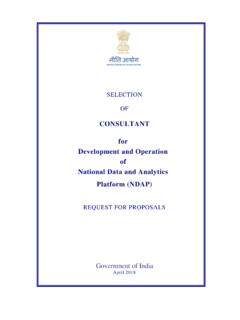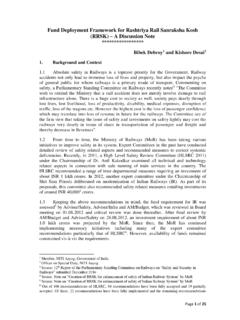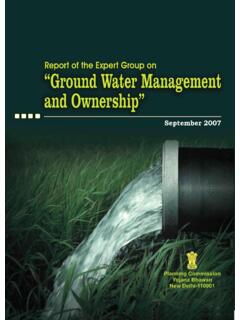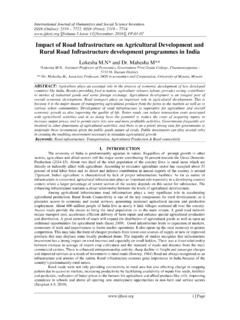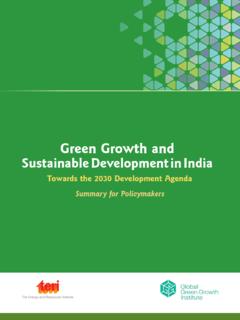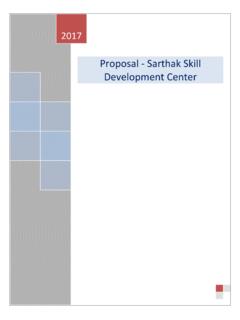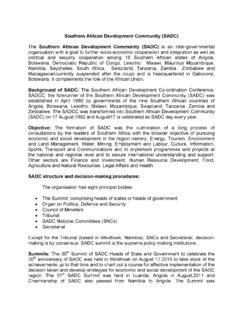Transcription of Entrepreneurship Development in India-the Focus on Start-ups
1 Special Report20 Laghu Udyog SamacharSpecial Article Entrepreneurship Development in India-the Focus on Start-ups Sunita Sanghi & A. Srija1 IntroductionIndia today has reached that stage of the demographic transition wherein more than 60 percent of the population is in the economically active age group of 15-59 years, commonly referred to as the DEMOGRAPHIC DIVIDEND. For india to tap this dividend it is necessary that the economy is able to generate enough job opportunities to productively absorb this economically active population. We do keep mentioning of 500 million strong workforce by 2022 but india faces challenges in reaping this demographic dividend considering that illiteracy levels among the labour force is still high and between 70-80 percent of the labour force have education levels below secondary.
2 Almost 48 percent of the workforce is engaged in agriculture while contribution of agriculture to GDP is not more than 16 percent. This situation may be attributed to the low level of education and thereby inability to access decent jobs in the non-farm sector. In terms of status of employment 52 percent of the workforce is self-employed as own-account workers or helpers, 30 percent as casual workers while only around 18 percent have regular jobs. This has resulted in more than 90 percent of the workforce engaged in informal jobs and slowing down the structural transition from farm to the non-farm sector. The policy Focus in the labour market has therefore been to create decent jobs which can give the workforce a reasonable standard of living.
3 While the emphasis has been on wage employment it has been felt essential to promote self-employment or to be specific Entrepreneurship as an entrepreneur would be in a position to create more in IndiaEntrepreneurship is not new to india . In fact to quote from the Indian Industrial Commission Report (1916-1918) "At a time when the West of Europe, the birth place of modern industrial system, was inhabited by uncivilized tribes, india was famous for the wealth of her rulers and for high artistic skill of her craftsmen. And even at a much later period, when the merchant adventures from the West made their first appearance in india , the industrial Development of this country was, at any rate, not inferior to that of the more advanced European nations." Entrepreneurship is not new to india .
4 In fact to quote from the Indian Industrial Commission Report (1916-1918) "At a time when the West of Europe, the birth place of modern industrial system, was inhabited by uncivilized tribes, india was famous for the wealth of her rulers and for high artistic skill of her craftsmen. And even at a much later period, when the merchant adventures from the West made their first appearance in india , the industrial Development of this country was, at any rate, not inferior to that of the more advanced European nations."Special Report21 January, 2016 Special Article In fact an earlier version of the current Make in india policy was the Swadeshi movement launched in 1905 during the pre-Independence era to boycott British made goods and use Indian made goods. The movement saw the Development of the Indian textile industry, the iron & steel industry by the Tatas, publishing of vernacular newspapers, setting up of vernacular medium educational institutions, financial institutions etc.
5 However, post-independence the policy Focus of increased public investment in heavy industries and setting up of PSUs did not provide an ideal environment for Entrepreneurship . The main problems faced by an entrepreneur were lack of mentoring facilities, technology support or easy availability of credit. Though different Reports on employment highlighted the need for promoting Entrepreneurship as means of self-employment, Entrepreneurship did not scale up. To mention a few, in the Gupta Special Group Report on Targeting 10 million Employment Opportunities Per Year (2002) recommended appropriate programmes should be launched to increase entrepreneurial capabilities and skill for self-employment. The Montek Singh Ahluwalia Report of the Task Force on Employment Opportunities , July 2001 also mentions about developing Entrepreneurship ability among the newly self-employed.
6 The Report even recommends Entrepreneurship training for the informal sector. To quote, A large part of the employment generated by the economy will be self-employment in the informal sector. These self-employed entrepreneurs need training of the multi-skill variety, going beyond production skills to include marketing, finance and accounting and elementary management. Such skills cannot be developed through structured formal training but requires the guidance of mentors in actual business conditions . However, Entrepreneurship in india has been confined to being own-account workers with one or more helpers and did not expand in size beyond that. As maybe seen from the Fifth Economic Census 2005, 95 percent of establishments were engaging not more than five workers and they accounted for almost 64 percent of the employment.
7 If the employment size of a unit is taken as not more than 10 workers then percent of the establishments are covered. (Table-1) Table-1 Distribution of Establishments by size class of by class of EmploymentItemYear11-5 Establishments199019982005 Persons usually usually & usually : Table , Chapter V, Fifth Economic Census 2005-All india Report, GoI22 Laghu Udyog SamacharSpecial Article To promote self-employment as a means of job-creation and to promote Entrepreneurship for further job creation, the Micro, Small and Medium Enterprises (MSME) Act, 2006 was enacted to facilitate the promotion, Development and enhancing the competitiveness of micro, small and medium enterprises. Earlier to that the small scale industries (SSIs) were regulated by two sections of the Industries ( Development & Regulation) Act, 1951 which led to absence of an institutional regulatory and consultative mechanism to capture and guide the progress of an SSI unit from being a micro unit to a small scale and eventually to medium scale one.
8 The earlier Act also excluded the fast emerging service sector2. But even after the implementation of the MSME Act, 2006 the high proportion of unregistered MSME units outside the purview of the Act is a matter of government has over time implemented policies for the promotion of the small industries which included providing concessional credit, training in Entrepreneurship Development , marketing assistance etc. But the entrepreneurial growth did not take off in a big way in india as compared to other countries because of the procedural hassles, stringent labour laws, economic regulations etc that the establishments had to face. Further with import liberalization and entry of MNCs into india , the Indian small scale entrepreneurs are not able to face the competition and are finding it difficult to survive.
9 In this context to quote from the Second National Commission on Labour (2002) New economic changes will provide more opportunities and not enough jobs. Therefore, one has to take advantage of the opportunities. Both in urban and rural areas, there may not be an impressive rise in wage employment but there will probably be enough scope for self-employment. The emphasis, therefore, has to be not on wage jobs but on creating self- employed persons or entrepreneurs. The entire system of training and education will have to give emphasis on the Development of Entrepreneurship .In keeping with this spirit the Ministry of MSME is implementing the Entrepreneurship Development and skill upgradation schemes through appropriate training facilities. The Ministry has set up three national level Entrepreneurship Development Institutes viz; The National Institute for Entrepreneurship and Small Business Development (NIESBUD)3 (1983) at Noida (Uttar Pradesh), National Institute for Micro, Small and Medium Enterprises (NI-MSME) (1960) at Hyderabad, and Indian Institute of Entrepreneurship (IIE)4 (1993) at Guwahati, to inculcate entrepreneurial culture especially among the first generation entrepreneurs.
10 There is the scheme for Providing Support for Entrepreneurial and Managerial Development of SMEs through Incubators in implementation since 2008. There is the MSME Technology Centres (earlier Tool Room & Technology Development Centres) which provide high end skill training to the youth. A national award scheme has been initiated by MSME for outstanding performance in Entrepreneurship , Research and Development , Innovation, Lean Manufacturing Techniques and Quality addition the creation of Self Help Groups cannot be underestimated. Self Help Group is a homogeneous group of micro entrepreneurs which are formed voluntarily to save whatever amount they can and mutually agree to contribute to a common fund of the group from which small loans are given to the members 23 January, 2016 Special Article for meeting their productive and emergent credit needs on rate of interest and terms decided by the group.


